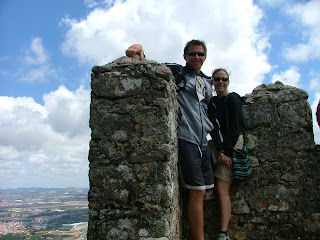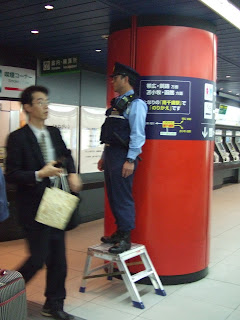
Portugal isn’t exactly a short, easy travel destination when your starting point is Japan but I had a conference there and Shawn came along and we stayed for a couple extra days of relaxation. The trip there from Japan is long but relatively painless. When we first arrived we had a day to explore the downtown area of Lisbon so we spent the day walking in the old district.
We stopped at an old church, soaked up the sun in the bustling main square, drank sangria at the base of St. Jorges castle and had a nice dinner. In Portugal, you have to make an effort NOT to have wine with dinner, and when you order wine the waiter brings a bottle, not a glass. We enjoyed a local vino verde (green wine, but it’s not actually green, it’s white with a bit of sparkle to it). The next day was conference time for me, and Shawn spent the day at the zoo in Lisbon. Day three, I was still in conference and Shawn spent more time exploring the city.

Our fourth day was the mid-point of the conference and the organizers built in an afternoon off with some planned excursions. Shawn and I joined the 4WD winery tour. We piled into 4WD trucks that took us along a coastal route to the winery where we stopped along the way to take in breathtaking views of the Atlantic Ocean. We drove along a dusty road through a vineyard and made a short stop to see a cork tree before arriving at the winery. We visited the Jose Maria da Fonseca winery, one of the oldest and largest in Portugal and famous for Moscatel wine (
read more about them here). We toured their newly built computerized winery first where they have capacity for 7 million litres of wine in fully automated stainless steel vats. From there we drove through a small town to the original site of the winery that is still in use today. We saw the old handmade mahogany wine casks that they can’t replace so have to still keep in continual use so they don’t shrink. We also got to peek in to see the family’s wine collection where they have been storing one keg and 30 bottles each year since 1834. The room, with dim lighting, spiderwebs covering every surface and Gregorian chant playing, was the perfect way to end the tour. From there we went to the tasting room and tried a few of their wines. We enjoyed all three that we tried, and liked Portugese wine in general.

The next day was another full day of conference followed by the conference banquet. We had an amazing dinner in a building that had been resorted after the Lisbon earthquake with beautiful arched brick walls and ceiling. Through dinner we were entertained by a Fado group, traditional Portugese singing accompanied by guitar (
more info on fado here). The room that we were in was perfect acoustics to accentuate the strength of their voices. After the banquet, most of the conference attendees made their way to the bar district in downtown Lisbon, where narrow streets wind up and down hills and small bars spill out into the cobble streets. Shortly after we arrived, the bars were supposed to stop serving and the police arrived to keep the crowds moving. The police didn’t really stop any of the drinking and just seemed to move us periodically from one bar to the next and the party continued for a few hours after “closing time”.
After the conference wrapped up the next day, we joined up with another couple of conference attendees and their spouses for a trip to Sintra. We stayed in a nice guest house near the train station, ate a tasty dinner and discussed our plans for the next day. Sintra is a small hillside town full of castles and amazing old architecture. A Moorish castle, dating back to the 7th century, overlooks the entire area and commands views of hundreds of kilometres in all directions. While at the top of the mountain, after walking around the castle walls, we visited the Palace of Pena which is only a short walk away. The palace is more recently built and is a unique mix of styles. It is colourful and well kept and contains plenty of treasures accumulated by the royal families.
 The view of the Moorish Castle looking up from Sintra.
The view of the Moorish Castle looking up from Sintra. Us on the castle wall overlooking Sintra and the Atlantic.
Us on the castle wall overlooking Sintra and the Atlantic. Looking across the hilltop to the Palace de Pena.
Looking across the hilltop to the Palace de Pena.Our final castle in Sintra was Quinta da Regaleira. This was by far our favourite and we could have spent an entire day exploring there. Built in 1910 by a rich doctor, the place is more a puzzle and piece of art than it is a castle. On the grounds of the estate, passageways, secret doors and hidden staircases interwoven with symbolism create a spooky and exciting atmosphere. We explored down winding narrow passageways in complete darkness, our camera batteries dead from using the flash to try to peer into the black to see if the tunnel ends of continues. The castle itself was also breathtaking, but we didn’t have much time to look around because we spent so much time on the grounds.
 Looking up from the bottom of a well - we ended up there after taking a passage hidden behind a waterfall and exited via the winding stairway.
Looking up from the bottom of a well - we ended up there after taking a passage hidden behind a waterfall and exited via the winding stairway.We enjoyed another nice meal and more Portugese wine, then visited a local pub on our way home. We sat and had a couple beers and chatted with our travel partners and soon the bar owner shut the doors explaining that the bar was “closed” but patrons who were already inside could continue drinking so long as the doors were closed. We stayed for another beer then gathered our things to leave, but the bar owner (who had joined us for the last beer) insisted that we stay for a taste of his uncle’s homemade cherry liquor. He poured it from a dusty old Jack Daniels bottle and it was sweet and strong, and failed to warn us about the potency of the cherry in the bottom of each glass. After more chatting with the bar owner about life as a young entrepreneur in Portugal, we finally made our way back to our guest house.

Groggy from the night before, we piled on a bus the next day in search of a beach. If we had more time, I would have stayed in Sintra for a few more days. It was such a romantic and beautiful spot and we didn’t see even a fraction of the things that there were to see there. We ended up at Praia das Macas, a small tourist town on a nice beach northwest of Lisbon. We found a room for the night and went to sit on the beach. The water was pretty cold, and the wind off the Atlantic was chilly so we hid out at a beachfront bar and sipped sangria and chatted with our travel partners (a couple from the US). Praia das Macas is quiet and had less European tourists than Sintra and has two other beaches within walking distance to the north and south.
 The town and beach at Praia das Macas
The town and beach at Praia das Macas
The next day it was time for us to make our way back to Lisbon and prepare to return to Japan. Along the way we stopped in Cascais, another tourist destination west of Lisbon. We only had time to take a walk along the waterfront and eat a nice meal, but Cascais seemed like a place that would have been nice to spend some more time in too. Our last night in Lisbon, we poured ourselves into a nice hotel facing the Rossio Square. We had a beautiful room with a view of Castelo St. Jorge from the balcony so we sat there and ate nice Portugese cheese and bread and toasted our last night with Port wine. The trip was too short to really see very much but it was nice and easy to travel there, and the weather was unbeatable.
































